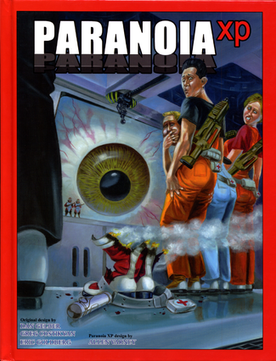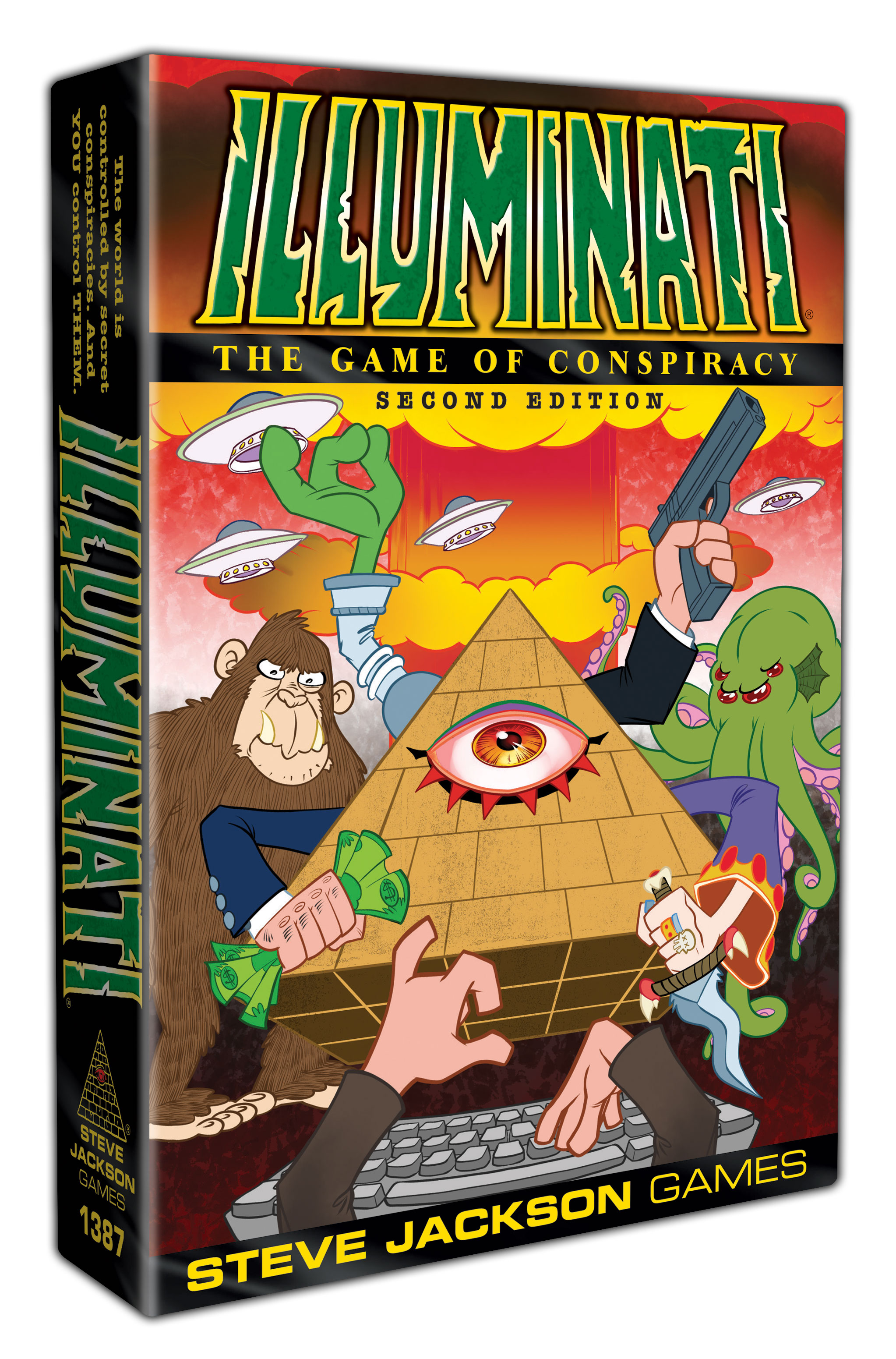A word of warning – this entry will be the first in a series about the role of conspiracy motifs in role-playing games, pen-and-paper ones to be exact (RPG). If you do not know what they are you are missing a lot, and you may find these posts a bit confusing. For this, I apologize.
 Now, the topic of how to use conspiracies and, more importantly, conspiracy theories, in RPGs has been on my mind for quite some time. Admittedly, there are a multitude of games that deal with this motif, either as an element of the setting, or as the axis around which the game revolves. Of the RPGs I know, the former could be the World of Darkness series released by White Wolf or FFG’s Dark Heresy and Black Crusade, as well as Warhammer Fantasy Role Playing. It can easily be found in any corporate setting, from Cyberpunk to Shadowrun. Examples of the former would be Paranoia, Conspiracy X and, to some degree, Eclipse Phase (EP), to which I will return in a moment.
Now, the topic of how to use conspiracies and, more importantly, conspiracy theories, in RPGs has been on my mind for quite some time. Admittedly, there are a multitude of games that deal with this motif, either as an element of the setting, or as the axis around which the game revolves. Of the RPGs I know, the former could be the World of Darkness series released by White Wolf or FFG’s Dark Heresy and Black Crusade, as well as Warhammer Fantasy Role Playing. It can easily be found in any corporate setting, from Cyberpunk to Shadowrun. Examples of the former would be Paranoia, Conspiracy X and, to some degree, Eclipse Phase (EP), to which I will return in a moment.
Truth be told, most RPG allow the usage of conspiracy theories and conspiracies, with some it will fit better, with others less. And here really lies the crux of the matter – how do I, as a GM, employ the conspiracy (theory) to benefit the plot and make it more fun. A number of approaches can be taken:
 1. The conspiracy theory is just a background, which may incite a feeling of paranoia among the PCs, but nothing more. The problem here is that unless the game is of the second type, this “flavour” will soon be lost due to more down-to-earth concerns, or be simply a quirk of some PC.
1. The conspiracy theory is just a background, which may incite a feeling of paranoia among the PCs, but nothing more. The problem here is that unless the game is of the second type, this “flavour” will soon be lost due to more down-to-earth concerns, or be simply a quirk of some PC.
2. The conspiracy is the antagonist – a shadowy group that the PCs strive to defeat and destroy. This would be the most standard application, different from any other RPG antagonist because of an air of secrecy.
3. A mixture of both, which would follow the pattern of spy movies or series like The X-files. Here the players would fight a conspiracy, only to find that these are only patsies of some greater power, which becomes the new antagonist. I tried to write such campaigns a number of times, but ended up dropping the motif. On the one hand, they can easily turn into a repetitive “monster of the week” sort of thing,
These would be the most obvious ones, but there is one more option:
4. The players are the conspiracy (theory). Believe it or not, at some points most of the campaigns will result in such a scenario. Don’t believe me? Let’s see... The PC will plot and conspire against the NPC, forming a tightly knit cabal intent on gaining more power and influence. Does sound familiar, right? What makes it even funnier, is that some RPGs, Eclipse Phase amongst them, encourage a similar style of play.
Point four, after some deliberating made me think of Richard Hofstadter again. In “The Paranoid Style...” essay he mentions one thing I failed to address in the previous posts. Namely, he notices that the conspiracy theorists (the enemies of the conspiracy) often form groups extremely similar to those they claim fight. Examples are numerous – Adam Weishaupt modelled the structure of the Bavarian Illuminati (the historical ones) on that of the Society of Jesus, while the members of the far-right John Birch Society formed “cells” just like the supposed Cold War Communist infiltrators. The reason, as other scholars suggested is that the theorists, deep in their hearts, want to emulate the conspiracy they are fighting against, to feel as all-powerful and in control as their enemies.
 And then in struck me: It is not the Game Master who should look how to use conspiratorial motifs, but the players. For the GM they are a problematic motif, for the PCs they are tons of fun.
And then in struck me: It is not the Game Master who should look how to use conspiratorial motifs, but the players. For the GM they are a problematic motif, for the PCs they are tons of fun.
Eclipse Phase, to my mind, is the perfect demonstration of how all the motifs describe above converge. Granted, I currently GM one campaign focused more on gatecrashing (exploration of other planets through stargate-like artefacts) than conspiracy, but with a setting like that conspiracy is almost a must. The tagline of the game is, after all, “roleplaying game of post-apocalyptic transhuman conspiracy and horror”. The introductory chapter of the book defines all of these themes, including what a conspiracy theory is:
‘To conspire means “to join in a secret agreement to do an unlawful or wrongful act or to use such means to accomplish a lawful end.” As such, a conspiracy theory attributes the ultimate cause of an event or a chain of events (whether political, societal or historical) to a secret group of individuals with immense power (political clout, wealth, and so on) who hide their activities from public view while manipulating events to achieve their goals, regardless of consequences. Many conspiracy theories contend that a host of the greatest events of history were initiated and ultimately controlled by such secret organizations. Of equal importance is the silent struggle between clandestine groups, waging a secret war behind the scenes to determine who influences the future.’
I love this definition. Of all that I have seen (non-academic ones at least), this is the best so far. What is great is that it immediately, though discretely, defines what is important for the game. Notice the last sentence; it is not something you would find in your typical anthology on conspiracy theories. We, as potential players and GMs learn what will be the focus of a conspiracy-heavy Eclipse Phase campaign – a “secret war behind the scenes”. This war, as the setting's most recent sourcebook Panopticon demonstrates, is not a lost cause, for transhumanity has even more means to detect groups trying to remain hidden than we have today.
But, just for the sake of it, let’s go through the points above in relation to EP:
Point one is easy enough. The book itself tells us that “the Fall left behind a persistent legacy of fear. This has faded over the past decade, but a great many humans still unconsciously expect the other shoe to drop and the TITANs to return at any moment”. So, the PCs can explore, smuggle, or play a political game, but the fear will be there, in the background, vocalised by some of the more paranoid NPC. It will, however, have little to with the plot itself.
 Point two can be used in a number of different ways. For a game that focuses so much on conspiracy, there are few “obvious” conspiratorial antagonists (in the sense of the Illuminati or the New World Order of our real world). The choices are, however, many. From the defined potential baddies of the Hypercorps and Project Ozma, through the followers of the TITANs, to the mysterious Prometheans. The problem here is that most of them would work in a rather similar manner; a better use would come through...
Point two can be used in a number of different ways. For a game that focuses so much on conspiracy, there are few “obvious” conspiratorial antagonists (in the sense of the Illuminati or the New World Order of our real world). The choices are, however, many. From the defined potential baddies of the Hypercorps and Project Ozma, through the followers of the TITANs, to the mysterious Prometheans. The problem here is that most of them would work in a rather similar manner; a better use would come through...
... point three, with the Hypercorps controlled by TITAN loyalists, who in turn are infiltrated by agents of the Prometheans, whose shadowy masters so far remain hidden. This is potentially the most fun version, with the PCs not really fighting the conspiracies, but rather trying to find out whether they pose a threat to transhumanity. This is, after all, the PC’s job in the generic EP campaign.
This brings us to point four, which seems the generic setting of the game. A typical EP group will be members of “Firewall”, a secretive organization that identifies and eliminates what they believe are threats to transhumanity. This part really blew my mind – these guys are exactly like the counter-conspiracies described by Hofstadter. They have a very rigid structure, opaque even to its own members. Field operatives, called “sentinels” are “soldiers of Firewall, the reserve troops called to instant active status whenever danger is perceived”. Just like the minutemen, or Communist agents, they live normal lives until they are told to go on a mission. Their “handlers” are called “proxies”, people who run the organization full time and have different roles, though no centralized leadership. Firewall can be quite nasty in their decisions, sacrificing human life if they feel the cause is just. They are different from their enemies only because they claim they’re “doing the right thing”.
There you have it, ladies and gentlemen. In Eclipse Phase, you are a member of a conspiracy waging a secret war against other conspiracies, with the continuous, paranoid feel that the more crazy conspiracy theories may turn out to be true, and all s*** will break loose.
The game is really fun and well researched, which many of my co-players confirmed. From my perspective, it is one of the best uses of the conspiracy theory motif in a work of popular culture. It avoids the fetishization of the term, escapes the worn-out cliches, and tries to answer the question how would conspiracy theory making and conspiracies work both in-world and for the players rolling the dice. By looking at this one slice of the setting, we can tell a lot about its culture, and it can give us lots of fun.
The game is really fun and well researched, which many of my co-players confirmed. From my perspective, it is one of the best uses of the conspiracy theory motif in a work of popular culture. It avoids the fetishization of the term, escapes the worn-out cliches, and tries to answer the question how would conspiracy theory making and conspiracies work both in-world and for the players rolling the dice. By looking at this one slice of the setting, we can tell a lot about its culture, and it can give us lots of fun.


will you be covering delta Gree/CoC et al or the fabulous game The Esoterrorists?
ReplyDeleteA fan theory states that the Alpha Complex is on Post-Fall Earth. For more information, click here:https://tvtropes.org/pmwiki/pmwiki.php/WMG/Paranoia
ReplyDelete